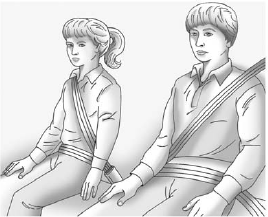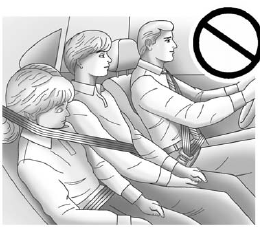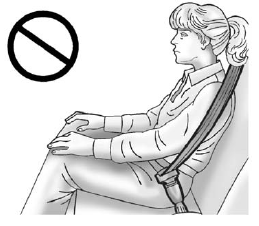Older Children

Older children who have outgrown booster seats should wear the vehicle safety belts.
The manufacturer's instructions that come with the booster seat state the weight and height limitations for that booster.
Use a booster seat with a lap-shoulder belt until the child passes the fit test below:
- Sit all the way back on the seat.
Do the knees bend at the seat edge? If yes, continue. If no, return to the booster seat.
- Buckle the lap-shoulder belt.
Does the shoulder belt rest on the shoulder? If yes, continue.
If no, try using the rear safety belt comfort guide. See “Rear Safety Belt Comfort Guides” under Lap-Shoulder Belt for more information.
If the shoulder belt still does not rest on the shoulder, then return to the booster seat.
- Does the lap belt fit low and snug on the hips, touching the thighs? If yes, continue. If no, return to the booster seat.
- Can proper safety belt fit be maintained for the length of the trip? If yes, continue. If no, return to the booster seat.
Q: What is the proper way to wear safety belts?
A: An older child should wear a lap-shoulder belt and get the additional restraint a shoulder belt can provide. The shoulder belt should not cross the face or neck. The lap belt should fit snugly below the hips, just touching the top of the thighs.
This applies belt force to the child's pelvic bones in a crash.
It should never be worn over the abdomen, which could cause severe or even fatal internal injuries in a crash.
Also see “Rear Safety Belt Comfort Guides” under Lap-Shoulder Belt.
According to accident statistics, children and infants are safer when properly restrained in a child restraint system or infant restraint system secured in a rear seating position.
In a crash, children who are not buckled up can strike other people who are buckled up, or can be thrown out of the vehicle. Older children need to use safety belts properly.
WARNING!
Never allow more than one child
to wear the same safety belt.
The safety belt cannot properly
spread the impact forces. In a
crash, they can be crushed
together and seriously injured.
A safety belt must be used by
only one person at a time.

WARNING!
Never allow a child to wear the
safety belt with the shoulder belt
behind their back. A child can be
seriously injured by not wearing
the lap-shoulder belt properly.
In a crash, the child would not be
restrained by the shoulder belt.
The child could move too far
forward increasing the chance
of head and neck injury.
The child might also slide under
the lap belt. The belt force would
then be applied right on the
abdomen. That could cause
serious or fatal injuries. The
shoulder belt should go over the
shoulder and across the chest.

See also:
Calling for Service
When calling Roadside Service,
have the following information
ready:
- Your name, home address, and
home telephone number.
- Telephone number of your
location.
- Location of the vehicle.
- ...
Auto Defog
This will allow you to turn the auto defog on or off.
Press the MENU/SELECT knob when Auto Defog is highlighted to open the menu.
Turn the knob to highlight On or Off. Press the knob to confirm th ...
Noise, Ride & Handling
Road and wind noise are low, but you'll hear more adjacent traffic than I'd
expect in a luxury crossover. The Lincoln MKX and GLK, to name a couple
competitors, are superior in this regard.
With ...






